A Silent Voice
 Welcome to the jungle
Welcome to the jungle
I was not a bully. I mean, not really. Probably. There was that one neighbourhood kid in elementary school who I could be quietly mean to while other kids took care of the actual bullying. He was kind of a jerk and he stole stuff from me and I did pee on his bike once. And there was that one kid in high school who was definitely bullied (not by me!) and who I drew an unflattering comic of. He was also pretty much a jerk, but by then I could understand why, so I felt more complicit in his misery when he saw the cartoon in which I depicted him as ugly and obnoxious. So maybe I only contributed to the systemic abuses of these two kids or maybe I was actually bullying—just not alpha bullying.
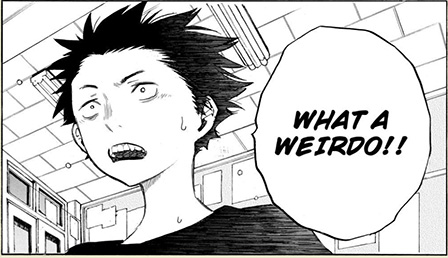 'Nuff said, I guess
'Nuff said, I guess
I wasn't bullied myself. I was merely Not Popular. I was vaguely smart (I actually repped my school in an academic decathalon thing), I was a reader, I liked comics, I didn't enjoy team sports (even though I was athletic enough), I never had a girlfriend, I had non-negligible acne. I was one of those quiet kids who's just likable enough to avoid the worst kind of attention. I never got beat up and I don't think I was ever trash-canned. I mean sure, I got punched in the arm a bit. Lots of charlie horses. I would be kicked from behind while urinating so I'd get pee all over my hands. And shorts. And underwear. So I don't know, maybe I was bullied. Just a bit. Just a taste.
Whatever the case, like many of the unpopular, I grew up to become a full-blown passive-aggressive bastard once I was a young adult. I didn't talk bad about people behind their backs and I was never violent or physically destructive, but I did make people around me feel like crap. I was tired of not having power but too timid to get it legitimately. So I abused people with off-hand comments and cutting cynicism. I hate the me that was, but that was the me that I was at the time. And struggling to lay that aside after a decade of behaving badly wasn't easy. So while I wasn't either mercilessly bullied or a merciless bully, I had enough of a taste of the whole thing to be fully invested in the dilemma presented in A Silent Voice.
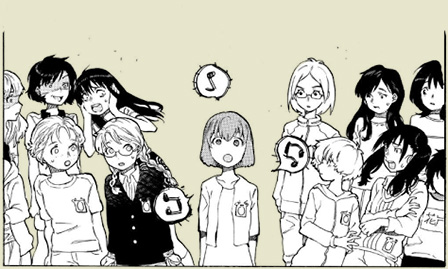 Sometimes the voice isn't all *that* silent
Sometimes the voice isn't all *that* silent
Some time ago, I ran into a scanlation of Yoshitoki Ōima's one-shot version of A Silent Voice. It was well-done, touching, sentimental, brutal, and warming. It struck a chord with me through the hazy recollection of my own history with bullies and bullying. Though it was just one of those short comics that you'll see linked on Reddit or wherever, Ōima's story of the deaf girl and the bully stayed with me—well enough that when I saw a series-long repurposement of the original on Crunchyroll Manga, I was immediately drawn in. An expansion on the original story seemed too delicious to pass up.
Ōima's original ended suddenly and happily, a moment of apology and repentance wiping away all scars. It was sweet and even powerful, but too pat. Like all short stories, it avoided the struggles that longer fiction has the opportunity to explore. With a series, the author would have the space to move beyond the pat answers and trite solutions. And so as a series, A Silent Voice crawls toward restoration with baby steps and miscommunications. And I am loving watching this story unfold. While it hasn't been published yet, the finale is not in question. This thing is going to end happily. We can chart that from miles away, but it doesn't matter. I don't care that the end will be predictable. I'm loving the ride and I'm loving the characters.
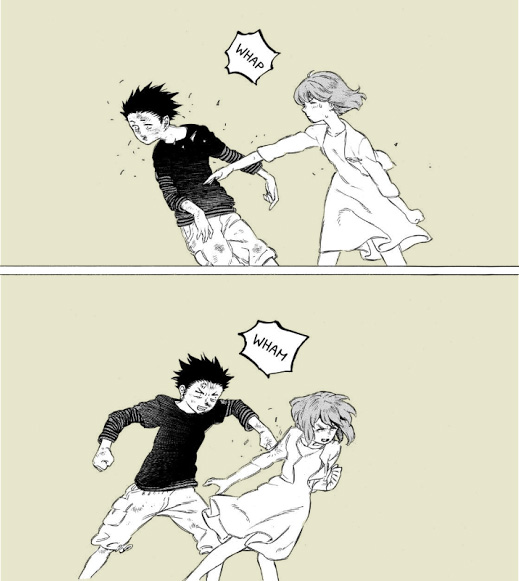 BIF POW BAM! Hey kids, comics!
BIF POW BAM! Hey kids, comics!
A Silent Voice begins with the story of two kids in elementary school—Shoya the reckless, popular kid and Nishimiya the new girl, who is deaf and communicates through writing in a notebook (since nobody knows sign language). Nishimiya's inability to hear and the problems that crop up as a result are too strange for Shoya and so, leading by example, he creates an environment in which Nishimiya is bullied daily and with extreme prejudice. She is scorned, mocked, and has her hearing aids repeatedly torn from her ears and destroyed. When it eventually becomes too much, the girl's mother complains and all blame is pushed onto Shoya's shoulders. From that point forward, he is systematically bullied by his former friends in a manner far more vicious than that with which he instigated against Nishimiya. His resentment against her swells, and he gets into a fistfight with the girl, prompting her mother to remove her from the school. Six years pass and Shoya endures trouble all through elementary school and junior high. Through hindsight and reflection, he finds himself reevaluating those early days, and now as a highschooler, Shoya seeks to have one final, repentant conversation with Nishimiya.
And the story moves on from there.
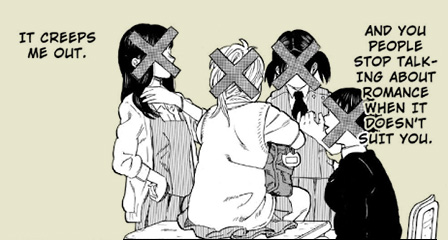 When Shoya is older, this is how Ōima represents his disassociation with other students.
When Shoya is older, this is how Ōima represents his disassociation with other students.
A Silent Voice is concerned with the transition from sociopathy11Non-clinical. to empathy. Just as I had to evolve from my early-twenties experience of passive aggression, so does Shoya seek to learn how to melt from his seclusion and inability to relate to others. While the details of his path are different from my own, it's comforting to see the generalities are not unique to myself. I don't usually look for representations of myself in the literature I take in, but for whatever reason I appreciate it in this case. Perhaps because I know that Shoya's story will end happily, it provokes hope for the conclusion to my own story.
As a storyteller, Ōima is perfectly suited to her task of unveiling A Silent Voice's trajectory. Her art is lovely and her framing and perspective dynamic. Her drawings convey a wealth of emotional information. Her elementary school kids look rather like children22Sadly, artists drawing believable children is a distinct rarity. and her highschool-aged versions of the same mature predictably, giving the reading a certain place to hang their hat. I love her art and that will probably be enough to interest me in any other projects she pursues.
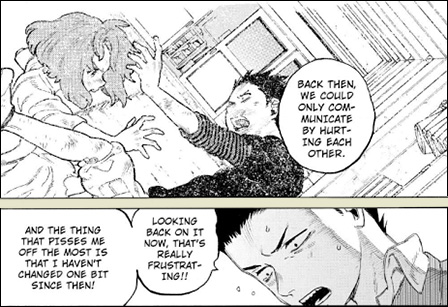 Voice and communication are overshadowing themes in Ōima's book
Voice and communication are overshadowing themes in Ōima's book
Also: these panels have not been altered and read from right to left.
If there is one issue with A Silent Voice, it's in a very particular aspect of the book's writing. On the main, Ōima does a pretty great job managing words and pictures to keep things moving well. The sole piece that causes me a small aggravation is that A Silent Voice's characters suffer from the same inability to communicate that plagues the protagonists of so many of the Korean dramas I love so much. Yards of storytelling would be tightened up if only characters would say what they were thinking instead of remaining muzzled or outright lying about their thoughts. Still, at the same time, one of the book's themes is how Shoya attempts to overcome the communication gulf that Nishimiya's deafness caused in their elementary school days. So it rather makes sense that even after conquering the sign language gap, the story should continue to explore different barriers to communication.
As a final note to how much I enjoy this series, I should say that the final couple paragraphs were written three weeks after the first several. I was in a motorcycle accident the day I intended to post this review and injured my arm. I have been unable to type more than a couple sentences at a time since then. I'm still having a lot of trouble but didn't want to let Good Ok Bad languish any longer than necessary. In any case, A Silent Voice was no longer fresh in mind, so I needed to glance at the first chapter to solidify some of the story details for the review. Within a few pages I had the information I needed, but before I noticed, I was already nine chapters in. I find Ōima's story that absorbing. I love this story, and while I enjoy the crisp presentation of Crunchyroll's manga app, I rather hope Kodansha will release this in paperback so I can always have it in hand to scratch the itch when it comes.
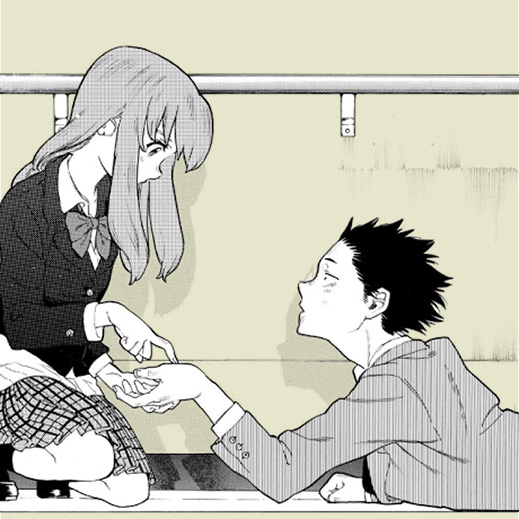
Good Ok Bad features reviews of comics, graphic novels, manga, et cetera using a rare and auspicious three-star rating system. Point systems are notoriously fiddly, so here it's been pared down to three simple possibilities:
3 Stars = Good
2 Stars = Ok
1 Star = Bad
I am Seth T. Hahne and these are my reviews.
Browse Reviews By
Other Features
- Best Books of the Year:
- Top 50 of 2024
- Top 50 of 2023
- Top 100 of 2020-22
- Top 75 of 2019
- Top 50 of 2018
- Top 75 of 2017
- Top 75 of 2016
- Top 75 of 2015
- Top 75 of 2014
- Top 35 of 2013
- Top 25 of 2012
- Top 10 of 2011
- Popular Sections:
- All-Time Top 500
- All the Boardgames I've Played
- All the Anime Series I've Seen
- All the Animated Films I've Seen
- Top 75 by Female Creators
- Kids Recommendations
- What I Read: A Reading Log
- Other Features:
- Bookclub Study Guides










